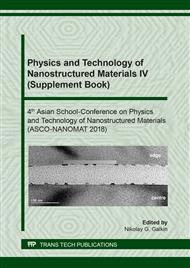[1]
I.E. Pamirsky, K.S. Golokhvast Silaffins of diatoms: from applied biotechnology to biomedicine // Marine Drugs. 11 (2013) 3155-3167.
DOI: 10.3390/md11093155
Google Scholar
[2]
K.S. Golokhvast, I.V. Seryodkin, V.V. Chaika, A.M. Zakharenko, I.E. Pamirsky Phytoliths in taxonomy of phylogenetic domains of plants // BioMed Research International. 2014 (2014) 1-9. Article ID 648326.
DOI: 10.1155/2014/648326
Google Scholar
[3]
K.S. Golokhvast, I.V. Seryodkin, E.M. Bulakh, V.V. Chaika, A.M. Zakharenko, A.S. Kholodov, I.E. Pamirsky, G. Chung. Mycoliths morphotypes and biosilification proteins in wood-destroying and pileate fungi // Botanica Pacifica 7 (2018).
DOI: 10.17581/bp.2018.07102
Google Scholar
[4]
I.E. Pamirsky, A.G. Klykov, G.A. Murugova, K.S. Golokhvast Silica biominerals (phytolith) compound of cultured barley plants (Hordeum vulgare l.) // IOP Conference Series: Materials Science and Engineering 225 (2017) article 012238.
DOI: 10.1088/1757-899x/225/1/012238
Google Scholar
[5]
K.S. Golokhvast, A.M. Zakharenko, V.V. Chaika, A.S. Kholodov, O.R. Kudryavkina, I.V. Seryodkin, A.A. Sergievich, A.A. Karabtsov Phytolithes (SiO2 microparticles) of some multicellular algae (Sea of Japan) // Der Pharma Chemica 7 No11 (2015) 307-311.
Google Scholar
[6]
D.R. Piperno Phytoliths: A Comprehensive Guide for Archaeologists and Paleoecologists. Lanham, Maryland: AltaMira Press (2006) 238.
Google Scholar
[7]
M. Saggu, J. Liu, A. Patel Identification of Subvisible Particles in Biopharmaceutical Formulations Using Raman Spectroscopy Provides Insight into Polysorbate 20 Degradation Pathway//Pharm Res. 32 (2015) 2877–2888.
DOI: 10.1007/s11095-015-1670-x
Google Scholar
[8]
T.B. Ball, J.S. Gardner, N. Anderson Dentifying inflorescence phytoliths from selected species of wheat (Triticum monococcum, T. dicoccon, T. dicoccoides, and T. aestivum) and barley (Hordeum vulgare and H. spontaneum) (gramineae) // American Journal of Botany. 86 No11 (1999) 1615–1623.
DOI: 10.2307/2656798
Google Scholar
[9]
T.B. Ball, R. Ehlers, M.D. Standing Review of typologic and morphometric analysis of phytoliths produced by wheat and barley // Breeding Science. 59 (2009) 505–512.
DOI: 10.1270/jsbbs.59.505
Google Scholar


